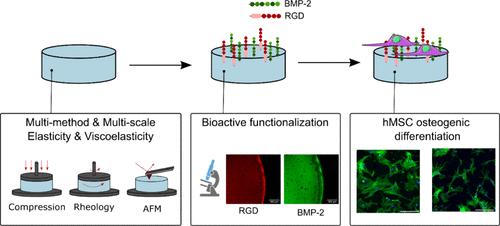当前位置:
X-MOL 学术
›
ACS Appl. Mater. Interfaces
›
论文详情
Our official English website, www.x-mol.net, welcomes your
feedback! (Note: you will need to create a separate account there.)
Integrating Mechanics and Bioactivity: A Detailed Assessment of Elasticity and Viscoelasticity at Different Scales in 2D Biofunctionalized PEGDA Hydrogels for Targeted Bone Regeneration
ACS Applied Materials & Interfaces ( IF 8.3 ) Pub Date : 2024-07-23 , DOI: 10.1021/acsami.4c10755 Cristina López-Serrano 1, 2, 3 , Yeva Côté-Paradis 2, 3 , Birgit Habenstein 4 , Antoine Loquet 4 , Cédric Le Coz 5 , Jean Ruel 6 , Gaétan Laroche 2, 3 , Marie-Christine Durrieu 1
ACS Applied Materials & Interfaces ( IF 8.3 ) Pub Date : 2024-07-23 , DOI: 10.1021/acsami.4c10755 Cristina López-Serrano 1, 2, 3 , Yeva Côté-Paradis 2, 3 , Birgit Habenstein 4 , Antoine Loquet 4 , Cédric Le Coz 5 , Jean Ruel 6 , Gaétan Laroche 2, 3 , Marie-Christine Durrieu 1
Affiliation

|
Methods for promoting and controlling the differentiation of human mesenchymal stem cells (hMSCs) in vitro before in vivo transplantation are crucial for the advancement of tissue engineering and regenerative medicine. In this study, we developed poly(ethylene glycol) diacrylate (PEGDA) hydrogels with tunable mechanical properties, including elasticity and viscoelasticity, coupled with bioactivity achieved through the immobilization of a mixture of RGD and a mimetic peptide of the BMP-2 protein. Despite the key relevance of hydrogel mechanical properties for cell culture, a standard for its characterization has not been proposed, and comparisons between studies are challenging due to the different techniques employed. Here, a comprehensive approach was employed to characterize the elasticity and viscoelasticity of these hydrogels, integrating compression testing, rheology, and atomic force microscopy (AFM) microindentation. Distinct mechanical behaviors were observed across different PEGDA compositions, and some consistent trends across multiple techniques were identified. Using a photoactivated cross-linker, we controlled the functionalization density independently of the mechanical properties. X-ray photoelectrin spectroscopy and fluorescence microscopy were employed to evaluate the functionalization density of the materials before the culturing of hMSCs on them. The cells cultured on all functionalized hydrogels expressed an early osteoblast marker (Runx2) after 2 weeks, even in the absence of a differentiation-inducing medium compared to our controls. Additionally, after only 1 week of culture with osteogenic differentiation medium, cells showed accelerated differentiation, with clear morphological differences observed among cells in the different conditions. Notably, cells on stiff but stress-relaxing hydrogels exhibited an overexpression of the osteocyte marker E11. This suggests that the combination of the functionalization procedure with the mechanical properties of the hydrogel provides a potent approach to promoting the osteogenic differentiation of hMSCs.
中文翻译:

整合力学和生物活性:对用于靶向骨再生的二维生物功能化 PEGDA 水凝胶不同尺度的弹性和粘弹性进行详细评估
在体内移植前促进和控制人间充质干细胞(hMSC)体外分化的方法对于组织工程和再生医学的进步至关重要。在这项研究中,我们开发了聚乙二醇二丙烯酸酯 (PEGDA) 水凝胶,其具有可调节的机械性能,包括弹性和粘弹性,以及通过固定 RGD 和 BMP-2 蛋白模拟肽的混合物实现的生物活性。尽管水凝胶机械性能与细胞培养具有关键相关性,但尚未提出其表征标准,并且由于采用的技术不同,研究之间的比较具有挑战性。在这里,采用综合方法来表征这些水凝胶的弹性和粘弹性,结合压缩测试、流变学和原子力显微镜 (AFM) 微压痕。在不同的 PEGDA 组合物中观察到了不同的机械行为,并且确定了多种技术的一些一致趋势。使用光活化交联剂,我们可以独立于机械性能来控制官能化密度。在hMSCs培养之前,采用X射线光电子光谱和荧光显微镜评估材料的功能化密度。与我们的对照组相比,即使在没有分化诱导培养基的情况下,在所有功能化水凝胶上培养的细胞在两周后仍表达早期成骨细胞标记物(Runx2)。此外,在成骨分化培养基培养仅1周后,细胞就表现出加速分化,不同条件下细胞之间观察到明显的形态差异。 值得注意的是,僵硬但应力松弛的水凝胶上的细胞表现出骨细胞标记物 E11 的过度表达。这表明功能化程序与水凝胶机械特性的结合提供了促进 hMSC 成骨分化的有效方法。
更新日期:2024-07-23
中文翻译:

整合力学和生物活性:对用于靶向骨再生的二维生物功能化 PEGDA 水凝胶不同尺度的弹性和粘弹性进行详细评估
在体内移植前促进和控制人间充质干细胞(hMSC)体外分化的方法对于组织工程和再生医学的进步至关重要。在这项研究中,我们开发了聚乙二醇二丙烯酸酯 (PEGDA) 水凝胶,其具有可调节的机械性能,包括弹性和粘弹性,以及通过固定 RGD 和 BMP-2 蛋白模拟肽的混合物实现的生物活性。尽管水凝胶机械性能与细胞培养具有关键相关性,但尚未提出其表征标准,并且由于采用的技术不同,研究之间的比较具有挑战性。在这里,采用综合方法来表征这些水凝胶的弹性和粘弹性,结合压缩测试、流变学和原子力显微镜 (AFM) 微压痕。在不同的 PEGDA 组合物中观察到了不同的机械行为,并且确定了多种技术的一些一致趋势。使用光活化交联剂,我们可以独立于机械性能来控制官能化密度。在hMSCs培养之前,采用X射线光电子光谱和荧光显微镜评估材料的功能化密度。与我们的对照组相比,即使在没有分化诱导培养基的情况下,在所有功能化水凝胶上培养的细胞在两周后仍表达早期成骨细胞标记物(Runx2)。此外,在成骨分化培养基培养仅1周后,细胞就表现出加速分化,不同条件下细胞之间观察到明显的形态差异。 值得注意的是,僵硬但应力松弛的水凝胶上的细胞表现出骨细胞标记物 E11 的过度表达。这表明功能化程序与水凝胶机械特性的结合提供了促进 hMSC 成骨分化的有效方法。











































 京公网安备 11010802027423号
京公网安备 11010802027423号